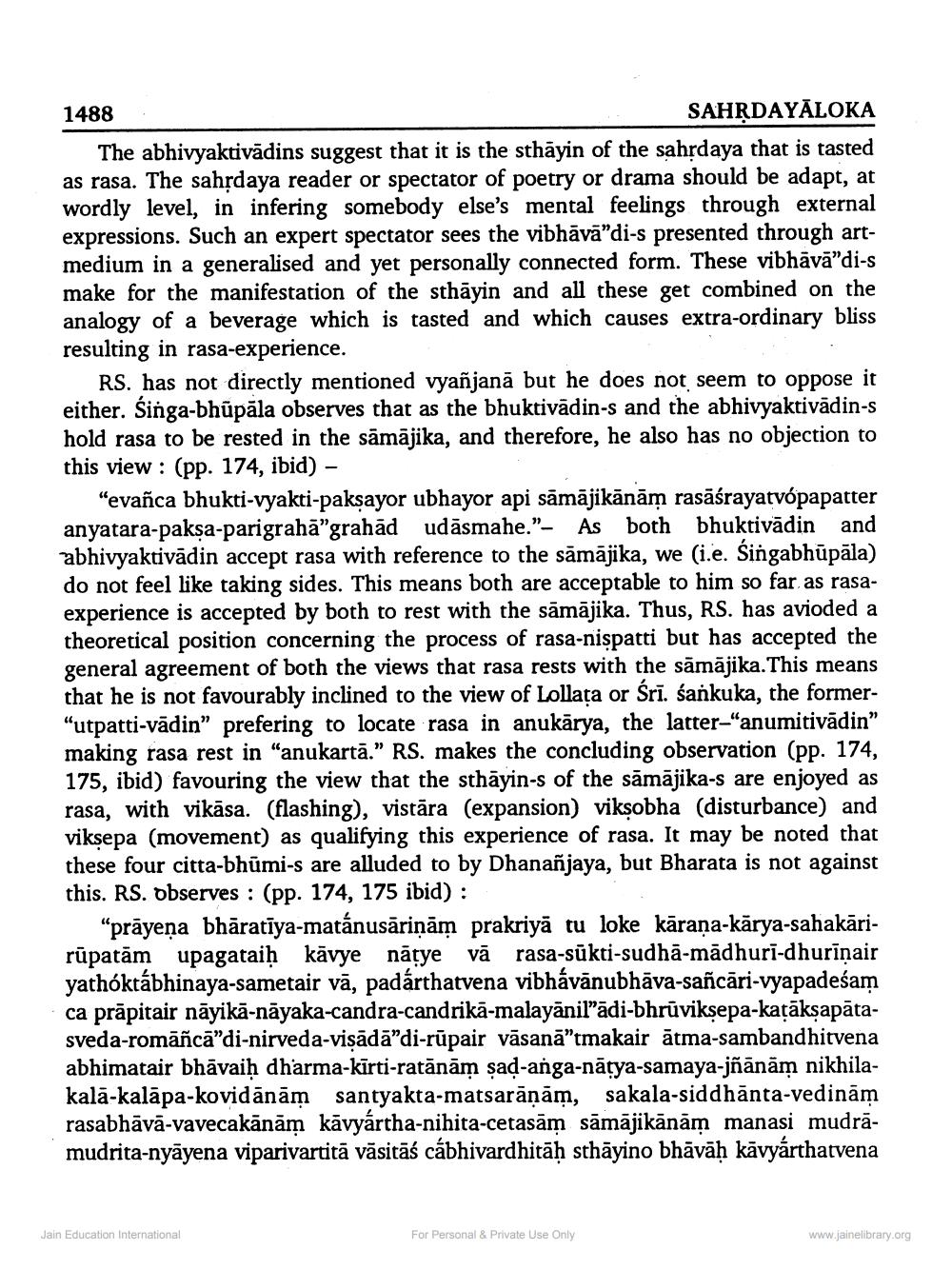________________
1488
SAHRDAYĀLOKA The abhivyaktivādins suggest that it is the sthāyin of the sahrdaya that is tasted as rasa. The sahşdaya reader or spectator of poetry or drama should be adapt, at wordly level, in infering somebody else's mental feelings through external expressions. Such an expert spectator sees the vibhāvā”di-s presented through artmedium in a generalised and yet personally connected form. These vibhāvā"di-s make for the manifestation of the sthāyin and all these get combined on the analogy of a beverage which is tasted and which causes extra-ordinary bliss resulting in rasa-experience.
RS. has not directly mentioned vyañjanā but he does not seem to oppose it either. Singa-bhūpāla observes that as the bhuktivādin-s and the abhivyaktivādin-s hold rasa to be rested in the sāmājika, and therefore, he also has no objection to this view : (pp. 174, ibid) -
“evañca bhukti-vyakti-pakşayor ubhayor api sāmājikānām rasāśrayatvopapatter anyatara-paksa-parigrahā”grahād udāsmahe."- As both bhuktivādin and abhivyaktivādin accept rasa with reference to the sāmājika, we (i.e. Singabhūpāla) do not feel like taking sides. This means both are acceptable to him so far as rasaexperience is accepted by both to rest with the sāmājika. Thus, RS. has avioded a theoretical position concerning the process of rasa-nispatti but has accepted the general agreement of both the views that rasa rests with the sāmājika. This means that he is not favourably inclined to the view of Lollața or Śrī. sankuka, the former"utpatti-vādinprefering to locate rasa in anukārya, the latter-"anumitivādin” making rasa rest in "anukartā.” RS. makes the concluding observation (pp. 174, 175, ibid) favouring the view that the sthāyin-s of the sāmājika-s are enjoyed as rasa, with vikāsa. (flashing), vistāra (expansion) vikșobha (disturbance) and viksepa (movement) as qualifying this experience of rasa. It may be noted that these four citta-bhūmi-s are alluded to by Dhananjaya, but Bharata is not against this. RS. Observes : (pp. 174, 175 ibid):
“prāyeņa bhāratīya-matánusāriņām prakriyā tu loke kārana-kārya-sahakārirūpatām upagataiḥ kāvye nātye vā rasa-sūkti-sudhā-mādhuri-dhurīnair yathóktábhinaya-sametair vā, padárthatvena vibhávānubhāva-sañcāri-vyapadeśam ca prāpitair nāyikā-nāyaka-candra-candrikā-malayānil”ādi-bhrūvikṣepa-katāksapātasveda-romāñcā"di-nirveda-visādā"di-rūpair vāsanā”tmakair ātma-sambandhitvena abhimatair bhāvaiḥ dharma-kīrti-ratānām şad-anga-nāțya-samaya-jñānām nikhilakalā-kalapa-kovidānām santyakta-matsarāņām, sakala-siddhānta-vedinām rasabhāvā-vavecakānām kāvyártha-nihita-cetasām sāmājikānām manasi mudrāmudrita-nyāyena viparivartitā vāsitāś cábhivardhitāḥ sthāyino bhāvāḥ kāvyárthatvena
Jain Education International
For Personal & Private Use Only
www.jainelibrary.org




